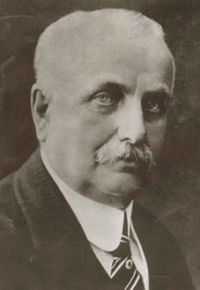Woolworth’s Early Life and Education
Frank Winfield Woolworth (1852–1919) was born in Rodman, New York, a small town in northwestern New York state, about 15 miles east of Lake Ontario.
Woolworth’s father and mother, whose roots were in England and Ireland, respectively, ran a farm and he worked at such common farm chores as feeding the cows from an early age.
Later in life, Woolworth said that he used to observe and enjoy the company of the peddlers who traveled door to door in those days. He also reported that one of the games he played at with his brother when he was still a young child included running his own country-style general goods store.
Woolworth dropped out of school at the age of 16 with the intention of seeking employment in such a store. However, no one would hire him with his minimal education and lack of experience.
For this reason, Woolworth attended courses at a business college in nearby Watertown, New York, for two semesters.
For the next several years, Woolworth continued working on the family farm.
Woolworth’s Career
In 1873, Woolworth finally obtained employment at a dry goods store in Watertown. In this position, he found that he enjoyed learning about business practices, dressing the show window, and keeping track of merchandise, more than he enjoyed trying to sell products.
This experience shaped the philosophy of retailing that Woolworth would later apply to his own stores, in which believed that the products should “sell themselves.”
Historians agree that Woolworth did not himself originate the “five and dime” concept (i.e., selling most goods for the low price of five or ten cents). However, accounts of how he first heard of the idea vary.
After the failure of the first store that Woolworth established on his own in 1878 in Great Bend, New York, he tried again the following year, opening a five-cent store in early 1879 in Utica, New York.
Woolworth’s second store failed, as well.
Nothing daunted, Woolworth opened his third store just two months later, this time in Lancaster, Pennsylvania. In this shop, he stocked more-expensive, ten-cent items. Thus, the Lancaster store was Woolworth’s first five-and-dime.
Finally, Woolworth’s formula proved successful. By 1889, he had opened 11 more stores designed along the same lines as the Lancaster store.
Once again, while Woolworth was not the originator of the concept of retail chain, he was the person who first succeeded in creating one on a large scale.
By 1900, the Woolworth’s chain consisted of 59 stores, with total annual sales in excess of $5 million.
By 1911, Woolworth had opened 586 stores, which he incorporated that year as the F.W. Woolworth Company.
Two years later, in 1913, Woolworth built a skyscraper in lower Manhattan to serve as his corporate headquarters. At 792 feet, the Woolworth Building was the tallest building in the world at that time.
In addition to the five-and-dime and retail chain concepts, a third ingredient in Woolworth’s success was his strategy of taking control of goods manufacturing and distribution in order to crowd out both middlemen and retail competitors.
During the late 1950s and early 1960s, five-and-dime stores began evolving into the larger, discount department stores of later decades. In 1962—long after its founder’s death—Woolworth’s began to spin off several new discount chains from the main corporation, notably, “Woolco.”
Selected Books About Woolworth and Woolworth’s
Baker, Nina Brown, Nickels and Dimes: The story of F.W. Woolworth (1954).
Brough, James, The Woolworths (1982).
Fenske, Gail, The Skyscraper and the City: The Woolworth Building and the Making of Modern New York (2008).
Frank, Dana, Women Strikers Occupy Chain Stores, Win Big: The 1937 Woolworth’s Sit-Down (2012).
McMillian, Don Daniel, The House of Woolworth (2007).
Morrison, Kathryn A., Woolworth’s: 100 Years on the High Street (2015).
Myers, Elisabeth P., F.W. Woolworth: Five and Ten Boy (1962).
Nash, Sunny, Bigmama Didn’t Shop at Woolworth’s (1996).
Nelson, George, F.W. Woolworth and the Five and Dime: From Nickels to Dimes to Dollars (2022).
Nichols, John Peter, Skyline Queen and the Merchant Prince: The Woolworth Story (1973).
O’Brien, O.J., We Shall Not Be Moved: The Jackson Woolworth’s Sit-In and the Movement It Inspired (2013).
Pitrone, Jean Madden, F.W. Woolworth and the American Five and Dime: A Social History (2003).
Plunkett-Powell, Karen, Remembering Woolworth’s: A Nostalgic History of the World’s Most Famous Five-and-Dime(1999).
Randall, Monica, Winfield: Living in the Shadow of the Woolworths (2003).
Walsh, Barbara, When the Shopping was Good: Woolworths and the Irish Main Street (2011).
Winkler, John K., Five and Ten: The Fabulous Life of F.W. Woolworth (1940; revised edition, 1957).
